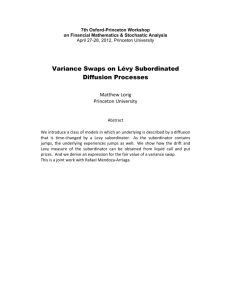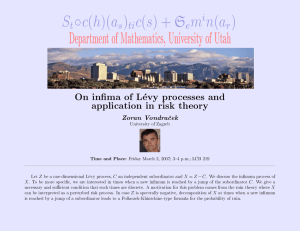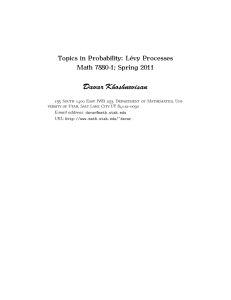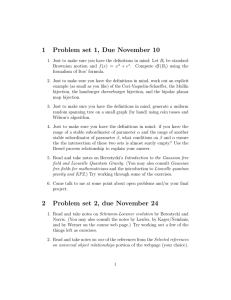Subordinators
advertisement
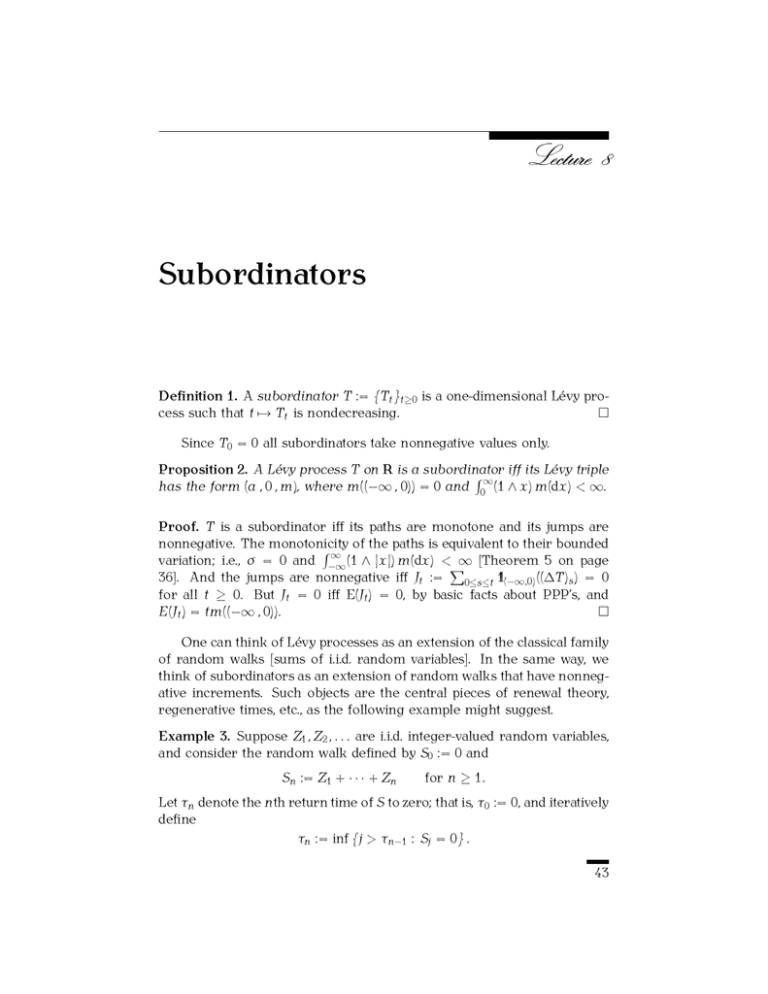
Subordinators
Definition 1. A subordinator T := {T� }�≥0 is a one-dimensional Lévy process such that � �� T� is nondecreasing.
�
Since T0 = 0 all subordinators take nonnegative values only.
Proposition 2. A Lévy process T on R is a subordinator
� ∞ iff its Lévy triple
has the form (� � 0 � �), where �((−∞ � 0)) = 0 and 0 (1 ∧ �) �(d�) < ∞.
Proof. T is a subordinator iff its paths are monotone and its jumps are
nonnegative. The monotonicity
� ∞ of the paths is equivalent to their bounded
variation; i.e., σ = 0 and −∞ (1 ∧ |�|) �(d�) <�∞ [Theorem 5 on page
36]. And the jumps are nonnegative iff J� :=
0≤�≤� 1l(−∞�0) ((∆T)� ) = 0
for all � ≥ 0. But J� = 0 iff E(J� ) = 0, by basic facts about PPP’s, and
E(J� ) = ��((−∞ � 0)).
�
One can think of Lévy processes as an extension of the classical family
of random walks [sums of i.i.d. random variables]. In the same way, we
think of subordinators as an extension of random walks that have nonnegative increments. Such objects are the central pieces of renewal theory,
regenerative times, etc., as the following example might suggest.
Example 3. Suppose Z1 � Z2 � � � � are i.i.d. integer-valued random variables,
and consider the random walk defined by S0 := 0 and
S� := Z1 + · · · + Z�
for � ≥ 1�
Let τ� denote the �th return time of S to zero; that is, τ0 := 0, and iteratively
define
τ� := inf {� > τ�−1 : S� = 0} �
43
44
8. Subordinators
If we define inf ∅ := ∞, then we find that the τ� ’s are increasing stopping
times. But also, because S has the strong Markov property [in the sense
of Math. 6040], {τ� − τ�−1 }∞
is a sequence of i.i.d. nonnegative random
� �=1
variables. Thus, τ� := ��=1 (τ� − τ�−1 ) is a nondecreasing random walk. In
other words, the successive return times of S to zero form a discrete-time
analogue of a subordinator.
Laplace exponents
It follows that if T is a subordinator, then there exists � ∈ R and a Lévy
�1
measure �, supported on (0 � ∞), such that 0 � �(d�) < ∞ and the Lévy
exponent of X is given by
� ∞�
�
Ψ(ξ) = −��ξ +
1 − e��ξ + �(�ξ)1l(0�1) (�) �(d�)
for all ξ ∈ R�
0
In the present setting,
�∞
(�ξ)1l(0�1) (�) �(d�) < ∞. Therefore, we can write
�
� ∞�
�
��ξ
E exp(�ξT� ) = exp ��ξ� − �
1−e
�(d�)
(ξ ∈ R)� (1)
where
0
�
0
� := � −
�
0
1
� �(d�)�
Because P{X� ≥ 0} = 1, both sides of (1) are analytic functions of ξ for
ξ in {� ∈ C : Re� ≥ 0}. In particular, we consider (1) for ξ := �λ, where
λ ≥ 0, and obtain the following: For all �� λ ≥ 0,
� ∞�
�
−λT�
−�Φ(λ)
Ee
=e
� where Φ(λ) := �λ +
1 − �−λ� �(d�)� (2)
0
By the uniqueness theorem for Laplace transforms, the function Φ determines the law of T uniquely.
Definition 4. The function Φ is called the Laplace exponent of the subordinator T. The constant � is called the drift of T.
�
Most people who study subordinators prefer to work with the Laplace
exponent rather than the Lévy exponent because the latter yields a more
natural “parametrization.” The following is an instance of this; it also explains why � is called the drift of T. In the next section we will see an
even more compelling instance of why we prefer to work with the Laplace,
rather than the Lévy, exponent of subordinators.
The following describes the local behavior of a subordinator; you can
find a good deal more information about this topic in the paper by Štatland
(1965).
Stable subordinators
45
Theorem 5 (A law of large numbers). If T is a subordinator with drift �
P
and Lévy measure �, then (T� /�) → � as � ↓ 0.
Proof. Thanks to (2) and the Lévy–Khintchine formula, we can write T� =
�� + S� , where {S� }�≥0 is a subordinator with Laplace exponent
� ∞�
�
Φ(λ) =
1 − e−λ� �(d�)�
0
It suffices to prove that S� = �(�) a.s. as � → ∞. But
� � ∞�
�
�
−�ξ�/�
�ξ(S� /�)
lim Ee
= lim exp −�
1−e
�(d�) = 1 for all ξ ∈ R�
�→0
�→0
0
thanks to the dominated convergence theorem. This proves that S� /� converges to 0 weakly, and hence in probability [since the limit 0 is nonrandom].
�
Stable subordinators
We have seen already one example of a subordinator [called the “Gamma
subordinator”] that has no drift and Lévy measure of the form �(d�)/d� =
α� −1 exp(−λ�)1l(0�∞) (�) [see page 12]. Next we introduce another.
Consider, a Borel measure �α on (0 � ∞) with density
�α (d�)
�
:= 1+α 1l(0�∞) (�)�
d�
�
where � > 0 is a constant. Then, �α is the Lévy measure of some Lévy
process iff α ∈ (0 � 2), yet �α is the Lévy measure of some subordinator iff
α ∈ (0 � 1).
Definition 6. A stable subordinator with index α ∈ (0 � 1) is a subordinator
with zero drift and Lévy measure �α .
�
In particular, if T is a stable subordinator with index α ∈ (0 � 1), then
Φ(λ) ∝ λ α for an arbitrary [but strictly-positive] constant of proportionality.
By changing the notation slightly, we can assume hereforth that T1 is
normalized so that
Ee−λT� = e−�λ
α
for all λ� � > 0�
We now study the local behavior of stable subordinators.
If T is a stable subordinator of index α ∈ (0 � 1), then T� = �(�) in
probability as � → 0+ . This finding can be sharpened in two different
ways; they are explained by our next two theorems.
46
8. Subordinators
Theorem 7 (Fristedt, 1967). Let T be a stable subordinator with index α ∈
(0 � 1). Then whenever � : (0 � ∞) → R+ is measurable and nonincreasing
with � �� � −1/α �(�) nondecreasing near � = 0,
�
�∞
0 if 1 [�(�)]−α d�/� < ∞,
T�
�∞
lim sup
=
�(�)
∞ if 1 [�(�)]−α d�/� = ∞�
�↓0
Theorem 8 (Fristedt, 1964; Khintchine, 1939). Let T be a stable subordinator with index α ∈ (0 � 1). Then there exists a positive and finite
constant K such that
� 1/α
T�
=K
a.s., where �(�) :=
�
lim inf
(1−α)/α
�↓0
�(�)
(ln ln(1/�))
Example 9. Thus, for example [a.s.],
T�
lim sup 1/α
= ∞ whereas
� · [ln(1/�)]1/α
�↓0
lim
�↓0 � 1/α
T�
= 0�
· [ln(1/�)]�/α
for every � > 1. Note also that Theorems 8 and 7 together imply that with
probability one, T� = � (1+�(1))/α a.s. as � ↓ 0.
�
Now we start the groundwork needed to prove Theorems 8 and 7. The
arguments rely on two probability estimates that are interesting in their
own right; namely, we need sharp estimates for P{T1 ≥ �} and P{T1 ≤ �}
when � is large and � > 0 is small.
Theorem 10. There exist positive and finite constants �1 and �2 —depending
on α ∈ (0 � 1) and � > 0—such that
�
�
�
�
�1 1 ∧ �−α ≤ P {T1 > �} ≤ �2 1 ∧ �−α
for all � > 0�
Proof. Because 1 − e−λT1 ≥ (1 − e−λ� )1l{T1 >�} for all λ > 0 and � > 1, we
can take expectations to find that
α
1 − e−λ
λα
1
�α
≤ inf
= α inf
�
−λ�
−λ�
λ>0 1 − e
λ>0 1 − e
� �>0 1 − e−�
�
This proves one bound. For the other, we note that T1 = �∈[0�1] (∆T)� ,
since T is monotonic, hence of bounded variation. In particular, T1 ≥
sup�∈[0�1] (∆T)� . Therefore,
�
�
P {T1 > �} ≥ P
1{(∆T)� >�} ≥ 1 = 1 − P
1{(∆T)� >�} = 0 �
P {T1 > �} ≤ inf
�∈[0�1]
�∈[0�1]
The sum of the
� ∞ indicators is Poisson with mean �([� � ∞)), which is proportional to � � −(1+α) d� ∝ �−α for � > 0. Therefore, there exists a
Stable subordinators
constant C such that P{T1 > �} ≥ 1 − e−C�
the theorem.
−α
47
for all � > 0. This proves
�
The preceding estimates the distribution of T1 near infinity. The following estimates it near zero.
Theorem 11. There exists a positive and finite constant Nα such that
�
�
Nα + �(1)
P {T1 ≤ �} = exp − α/(1−α)
as � ↓ 0�
�
Proof. Note that T1 ≤ � if and only if exp(−λT1 ) ≥ exp(−λ�), where λ > 0
is arbitrary. Therefore, Chebyshev’s inequality tells us that
�
�
να
λ�
−λT1
λ�−λ α
P {T1 ≤ �} ≤ inf e Ee
= inf e
= exp − 1/(1−α) �
λ>0
λ>0
�
where
να := αα/(1−α) (1 − α)�
and this is positive since α ∈ (0 � 1). This proves that if Nα exists then it is
certainly bounded below by να > 0.
In order to derive the more interesting lower bound, I will apply an
elegant rescaling argument (Griffin, 1985). Let us first note that if T(�+1)/� −
T�/� ≤ �/� for all 0 ≤ � < �, then certainly
� �
�
T1 =
T(�+1)/� − T�/� ≤ ��
0≤�<�
Therefore, by the independence of the increments of the process T,
� �
�� � �
� ���
P T(�+1)/� − T�/� ≤
P {T1 ≤ �} ≥
= P T1/� ≤
�
�
�
0≤�<�
Because T1/� has the same distribution as �−1/α T1 , we can deduce the
recursive inequality,
� �
���
P {T1 ≤ �} ≥ P T1 ≤ � · �(1−α)/α
�
Now we select � by setting � := [(γ/�)α/(1−α) ], where [•] := the greatestinteger function. It follows easily from this that
Consequently,
α/(1−α) ]
P {T1 ≤ �} ≥ [P {T1 ≤ γ}][(γ/�)
�
lim inf � α/(1−α) ln P {T1 ≤ �} ≥ sup γ α/(1−α) ln P {T1 ≤ γ} �
�↓0
γ>0
48
8. Subordinators
In particular, the lim inf is a genuine limit and equal to −Nα , which is
strictly greater than −∞ [since P{T1 ≤ γ} > 0 for γ sufficiently large].
This completes the proof.
�
Remark 12. We showed in the proof that Nα ≥ να . Large-deviations
methods can be used to show that this inequality is in fact an identity;
and the ensuing proof will show that the constant K in Theorem 7 is
K = α · β β/α for β := 1 − α. Exercise 3 below outlines the starting point of
this approach.
�
Proof of Theorem 7. Let �� := 2−� and note that
� ∞
∞
�
d�
��
I(�) :=
<
∞
iff
< ∞�
α
α
[�(�)]
[�(�
� )]
1
�=1
[Cauchy’s test.] It is easy to check that T� has the same distribution as
� 1/α T1 ; we simply check the characteristic functions. With this fact in
mind, we apply Theorem 10 to find that
�
�
∞
∞
∞
�
�
�
�(�� )
��
P {T��−1 > �(�� )} =
P T1 > 1/α ≤ const ·
�
[�(�� )]α
�
�
�=1
�=1
�=1
Therefore, whenever I(�) < ∞, the Borel–Cantelli lemma ensures that,
with probability one, T��−1 ≤ �(�� ) for all but a finite number of �’s. Now we
apply a monotonicity/sandwich argument [as in the proof of the strong law
of large numbers in Math. 6040]: If � ∈ [�� � ��−1 ], then T� ≤ T��−1 ≤ �(�� ) ≤
�(�) for all � sufficiently small; consequently we have lim�↓0 (T� /�(�)) ≤ 1 a.s.
Because I(�) < ∞ implies that I(κ�) < ∞ for arbitrarily small κ > 0, it
follows that T� /�(�) → 0 a.s.
The converse is proved similarly:
∞
�
�=1
P {T��−1
�
∞
�
− T�� ≤ �(��−1 )} =
P T1 ≤
�(��−1 )
(��−1 − �� )1/α
�=1
�
�
∞
�
�(��−1 )
=
P T1 ≤
(2�� )1/α
�=1
≥ const ·
∞
�
�=2
��
�
[�(�� )]α
�
Therefore, I(�) = ∞ implies that a.s., T��−1 − T�� > �(��−1 ) infinitely often
[Borel–Cantelli lemma for independent events]. Since T�� ≥ 0, this does
the job.
�
Now we prove the limit theorems mentioned earlier.
Stable subordinators
49
Proof of Theorem 8. Since T� has the same distribution as � 1/α T1 , we
obtain the following from Theorem 11: For all γ > 0,
�
�
γ
P {T� ≤ γ�(�)} = P T1 ≤ �
�(1−α)/α
ln ln(1/�)
�
�
= exp −Nα γ −α/(1−α) ln ln �(1 + �(1) �
�
�−ν+�(1)
= ln(1/�)
as � ↓ 0�
where ν := Nα γ −α/(1−α) . This sums along � = �� , provided that ν > 1 and
� ∈ (0 � 1). Because � �� T� is nondecreasing, a monotonicity/sandwich
argument [as in the 6040 proof of the LIL] proves that
lim inf
�↓0
T�
(1−α)/α
≥ Nα
�(�)
a.s.
(3)
For the converse we continue using the notation ν := Nα γ −α/(1−α) . But
now we consider the case that ν < 1. Let us also redefine �� := exp(−�� )—
where � > 1 is to be chosen in a little bit—and then note that
�
�
�(��−1 )
P {T��−1 − T�� ≤ γ�(��−1 )} = P T1 ≤ γ
(��−1 − �� )1/α
= exp (−(ν + �(1)) ln ln(1/��−1 ))
= �−(ν�+�(1)) �
since ��−1 − �� ∼ �� as � → ∞. It follows that
�
P {T��−1 − T�� ≤ γ�(��−1 )} = ∞ provided that 1 < � < ν −1 .
�
The Borel–Cantelli lemma for independent events implies that if 1 < � <
ν −1 , then
T� − T��
lim inf �−1
≤ γ a.s.
(4)
�→∞
�(��−1 )
At the same time, it is possible to apply Theorem 10 to obtain the following:
For all � > 0 and � large,
�
�
(��−1 /�� )1/α
P {T�� ≥ ��(��−1 )} = P T1 ≥ �
(ln ln(1/��−1 ))(1−α)/α
(ln ln(1/��−1 ))(1−α)
��−1 /��
(1−α)
�
=
�
exp {���−1 (1 + �(1))}
≤ const ·
50
8. Subordinators
Because � > 1 and � > 0 is arbitrary, the preceding estimate and the
Borel–Cantelli lemma together imply that T�� = �(�(��−1 )) a.s. as � → ∞.
Consequently, (4) tells us that
T��−1
T�
lim inf
≤ lim inf
≤ γ a.s.�
�→∞ �(��−1 )
�↓0
�(�)
(1−α)/α
as long as ν < 1; i.e., γ < Nα
. It follows that the inequality in (3) can
be replaced by an identity; this completes our proof.
�
Subordination
Let X denote a symmetric Lévy process on R� with Lévy exponent Ψ, and
suppose T is an independent subordinator [on R+ , of course] with Laplace
exponent Φ. Because Ψ is real [and hence nonnegative], it is not hard to
see that the process Y := {Y� }�≥0 , defined as
Y� := XT�
for � ≥ 0�
is still a symmetric Lévy process. Moreover, by conditioning we find that
�
�
Ee�ξ·Y� = E e−T� Ψ(ξ) = e−�Φ(Ψ(ξ))
for all � ≥ 0 and ξ ∈ R� �
We say that Y is subordinated to X via [the subordinator] T. Let us summarize our findings.
Proposition 13 (Subordination). If X is a symmetric Lévy process on R�
with Lévy exponent Ψ and T is an independent subordinator with Laplace
exponent Φ, then Y := X ◦ T is a symmetric Lévy process on R� with Lévy
exponent Φ ◦ Ψ. If X is isotropic, then so is X ◦ T.
If T is a stable subordinator with index α ∈ (0 � 1), then Φ(λ) ∝ λ α .
Since the Lévy exponent of standard Brownian motion is Ψ(ξ) = 21 �ξ�2 ,
we immediately obtain the following.
Theorem 14 (Bochner). Let X denote standard �-dimensional Brownian
motion, and T an independent stable subordinator with index α ∈ (0 � 1).
Then X ◦ T is an isotropic stable process with index 2α.
Because 2α ∈ (0 � 2) whenever α ∈ (0 � 1), the preceding tells us that
we can always realize any isotropic stable process via a subordination of
Brownian motion!
Theorem 15. Let X be a �-dimensional random variable whose law is
isotropic stable with index α ∈ (0 � 2). Then there exist �1 � �2 ∈ (0 � ∞)
such that
�1
�2
≤ P {�X� > �} ≤ α
for all � > 1�
α
�
�
Problems for Lecture 8
51
This theorem improves on Proposition 2 (page 11), which asserted that
E(�X�β ) < ∞ if β < α, but not if β ≥ α.
Proof. We know that X has the same law as Y1 , where Y := {Y� }�≥0 is
an isotropic stable process on R� . We can realize Y as follows: Y� = BT�
where B is �-dimensional Brownian motion, and T an independent stable
subordinator with index α/2. Therefore, by scaling,
�
�
�2
P {�X� > �} = P {�BT1 � > �} = P T1 >
�
�B1 �2
It follows easily from Theorem 10 [after conditioning on B] that there are
constants �1 and �2 such that for all � > 0,
�
�
�
�
�B1 �α
�B1 �α
≤ P {�X� > �} ≤ �2 E 1 ∧
�
�1 E 1 ∧
�α
�α
And by the dominated convergence theorem, the two expectations are
equal to �−α E(�B1 �α )(1 + �(1)) as � → ∞.
�
Problems for Lecture 8
Throughout these problems, T := {T� }�≥0 denotes a subordinator with drift �,
Lévy measure �, and Laplace exponent Φ.
�∞
1. Prove that E(T� /�) = limλ↓0 Φ(λ)/λ = 0 � �(d�) for all � ≥ 0. Construct an
example where E(T� ) = ∞ for all � > 0.
2. Let B denote one-dimensional Brownian motion, and define
T� := inf{� > 0 : B� > �}
(� ≥ 0� inf ∅ := ∞)�
(1) Prove that {T� }�≥0 is a subordinator, and for all �� �� � ≥ 0,
� � −� 2 /(2�)
� �
�
�
e
P T�+� − T� ≤ � � �� = √
d�
a.s.
�3/2
2π 0
�∞
(2) Conclude that T� = 0 � Π� (d�), for a Poisson point process {Π� }�≥0
�
with intensity d� × ρ(d�), where ρ(A) := (2π)−1/2 A � −3/2 d�.
(3) Show that the Laplace exponent of T is
� ∞
�
� d�
Φ(λ) :=
1 − e−λ�
�
� 3/2
0
Conclude that T is a stable subordinator of index 1/2 (see Lévy, 1992,
Théorème 46.1, p. 221).
3 (Girsanov transformations). Let T be a subordinator with drift � and Laplace
exponent Φ. Define {�� }�≥0 to be the natural filtration of T.
(λ)
(1) Prove that M� := exp(−λT� + �Φ(λ)) defines a nonnegative mean-one
cadlag martingale with respect to {�� }�≥0 ;
52
(λ)
8. Subordinators
(2) For every λ > 0 and � ≥ 0 define P(λ) (A) := E[M� ; A] for all A ∈ �� .
Prove that P(λ) is defined consistently as a probability measure on the
measurable space (Ω � �∞ ), where �∞ := ∨�≥0 �� ;
(3) Prove that T is a subordinator under the measure P(λ) . Compute the
drift, and more generally Laplace exponent, of T under the new measure
P(λ) ;
(4) Prove that P(λ) {lim�↓0 (T� /�) = Φ� (λ)} = 1. Compare with Theorem 5 on
page 45;
(5) Prove that when �� λ > 0, E(λ) (T� ) = �Φ� (λ) and Var(λ) (T� ) = −�Φ�� (λ),
where E(λ) and Var(λ) respectively denote the expectation and variance
operators for P(λ) ;
(6) Examine all of the preceding in the special case that T is a stable subordinator with index α ∈ (0 � 1).
4. Prove that if the
� Lévy measure � of a Lévy process X is supported in a
compact set and R� ���γ �(d�) < ∞ for some γ ∈ (0 � 1], then we can write
X� = −�� + σB� + T� − S� , where T and S are independent subordinators, and B
is an independent Brownian motion (Millar, 1971).
